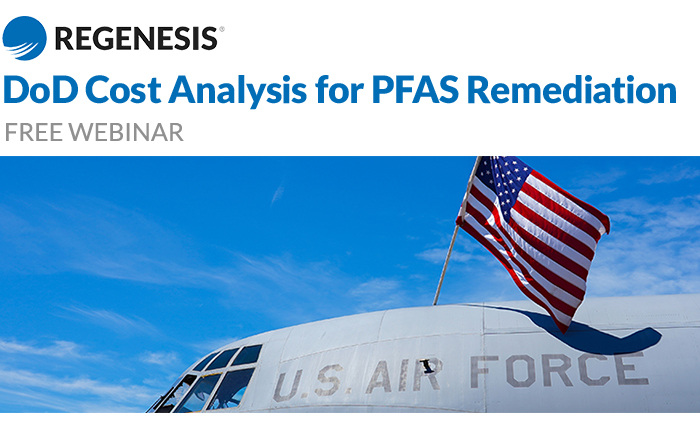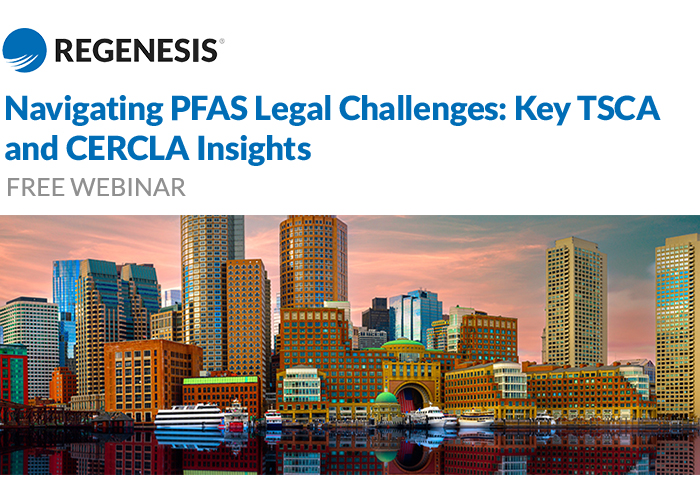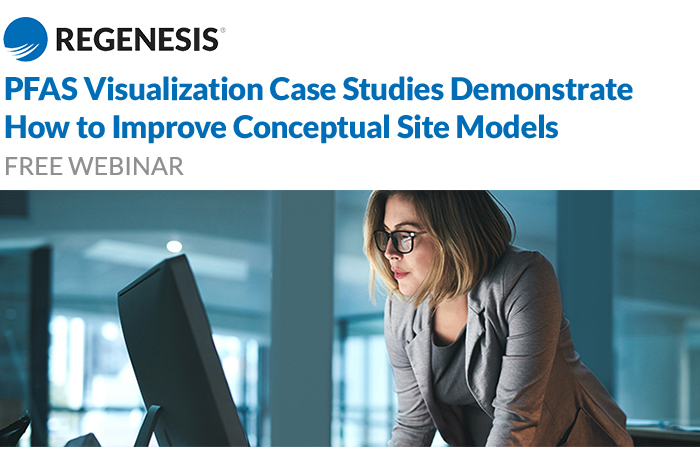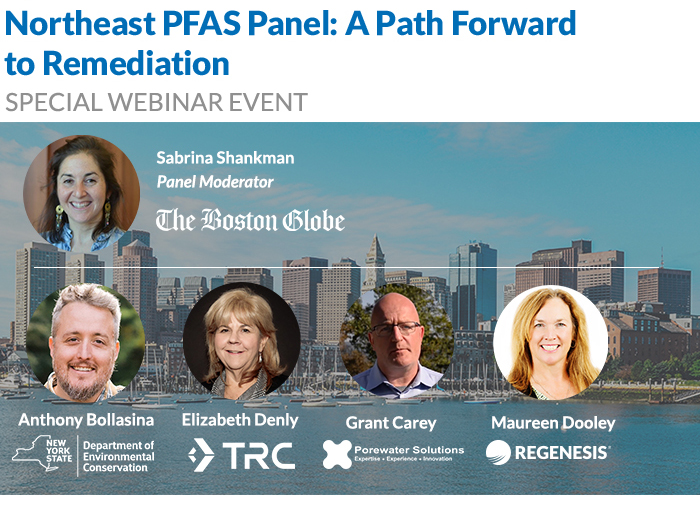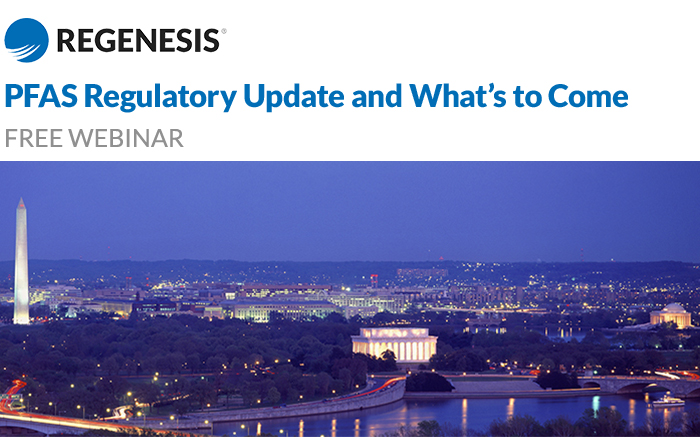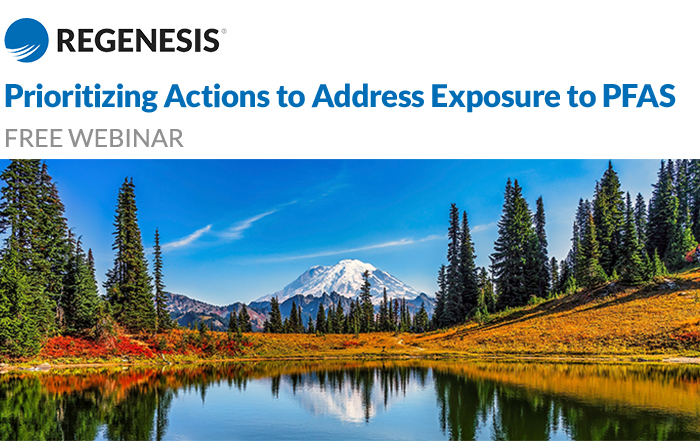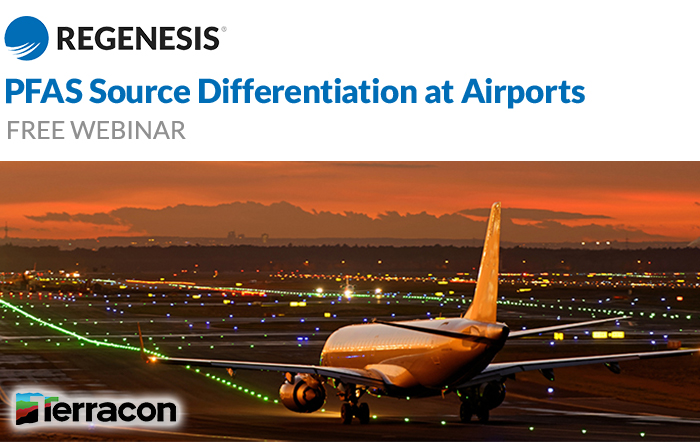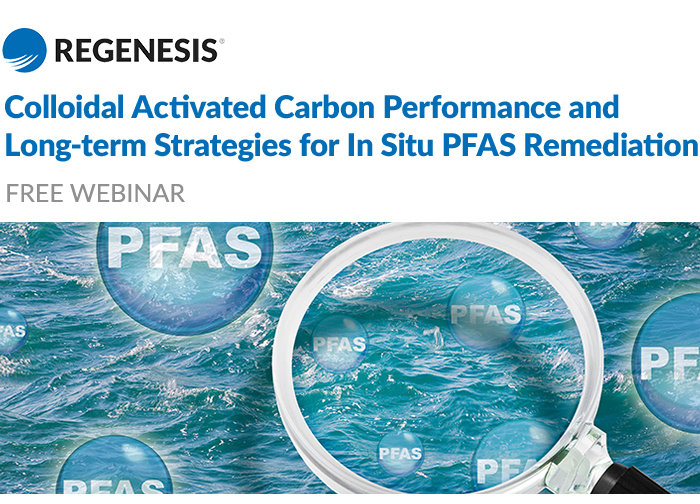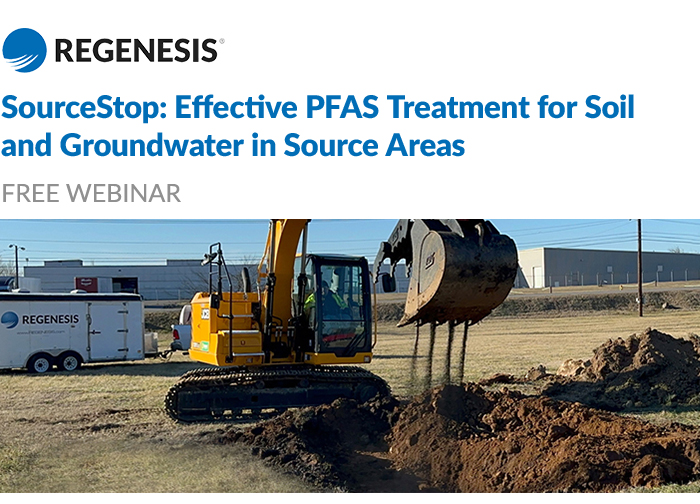DoD Cost Analysis for PFAS Remediation
In this webinar we were pleased to have special remediation expert speaker Dr. Jeremy Birnstingl, REGENESIS Vice President – Environmental Technology. His presentation discussed a cost analysis for PFAS remediation at DoD sites.
Highlights of this free webinar:
- Wurtsmith Air Force Base research study – Discloses the high cost the DoD is paying to contain a PFAS plume at an existing pump and treat installation
- Detailed cost comparison – Comparing the costs of the current system with the costs of an in situ CAC filtration system
- Pump and Treat will not flush PFAS from the aquifer – even after 100+ years of pumping
- Over 60% Cost Savings – For the subject site, in situ CAC filtration was shown to be about 1/3 the cost of pump and treat systems over a 30-year period ($7.2M vs $19M)
Complete the form on this page to view this free webinar.
About the Presenter:
 Jeremy Birnstingl, BSc, PhD, FRSC, CEnv.
Jeremy Birnstingl, BSc, PhD, FRSC, CEnv.
REGENESIS Vice President – Environmental Technology
Dr. Birnstingl serves as a senior REGENESIS technical resource on key remediation projects involving advanced in situ technologies worldwide. He is the author of the PlumeForce™ software used for design and modelling of the REGENESIS activated carbon-based technologies. Dr. Birnstingl received a B.Sc. (Hons.) Environmental Biology from the University of Essex and a Ph.D. in Environmental Chemistry from the University of Lancaster. He is a Fellow of the Royal Society of Chemistry in the United Kingdom and a Chartered Environmentalist. He has over 30 years’ experience in the commercial and academic environmental sectors including 20 in REGENESIS. His creative and scientific insight have been recognized through three commercial patents.
Webinar recording now available
Navigating PFAS Legal Challenges: Key TSCA and CERCLA Insights
In this webinar we were pleased to have a presentation by Brian D. Gross, Partner at MG+M The Law Firm. His presentation discussed navigating PFAS legal challenges related to the Toxic Substances Control Act (TSCA) and Comprehensive Environmental Response, Compensation and Liability Act (CERCLA). He was joined by Maureen Dooley, Vice President – Industrial Sector at REGENESIS.
Highlights of this free webinar:
- TSCA PFAS reporting requirements – Who must report, what they must report, when they must report, and strategies for due diligence to ensure compliance
- CERCLA – EPA’s promulgation of Maximum Contaminant Levels for PFAS in drinking water, and legal challenges to these rules
- U.S. Supreme Court – Recent abrogation of the “Chevron Doctrine” and its likely impact on legal challenges to EPA’s regulatory efforts
Complete the form on this page to view this free webinar.
About the Presenters:
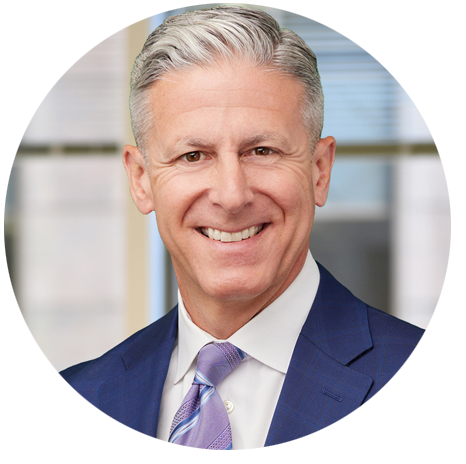 Brian D. Gross
Brian D. Gross
Partner, MG+M The Law Firm
Brian Gross has an exceptional track record of finding client-oriented solutions to complex legal issues. As counsel for several entities facing government enforcement and civil class actions relating to multiple contaminants, including PFAS, Brian develops strategies not only to eliminate or mitigate the liability of his clients, but also to recover the costs associated with investigation and remediation. In addition, Brian counsels clients concerning environmental contamination and potential liabilities that may arise from industrial, manufacturing and other processes. This includes the development of programs for compliance with federal, state and local environmental regulations and the counseling of companies and investment firms concerning environmental issues, including PFAS, for corporate transactions, investment decisions, and to avoid future litigation.
 Maureen Dooley
Maureen Dooley
Vice President – Industrial Sector, REGENESIS
Maureen Dooley has over twenty-five years of experience in many aspects of the remediation industry, including project management, research and development, senior technical oversight, remedial design and laboratory management. Her prior experience includes the completion of numerous treatability studies designed to evaluate the biodegradation of a wide range of chemical constituents including chlorinated solvents, petroleum hydrocarbons, explosives, aromatic hydrocarbons, and pesticides. In her current role at REGENESIS, she provides technical leadership for complex soil and groundwater remediation projects, including PFAS contamination treatment, throughout North America, as well as remediation design, strategy, and business development in the United States and Canada.
Webinar Recording Now Available
PFAS Visualization Case Studies Demonstrate How to Improve Conceptual Site Models
In this webinar we were pleased to have a presentation by Grant Carey, PhD, President of Porewater Solutions. His presentation discussed PFAS visualization case studies that demonstrate how to improve conceptual site models.
Highlights of this free webinar:
- Optimize PFAS site characterization, remedy evaluation, and forensic assessment with radial and stacked bar visualizations
- Improve site mapping using PFAS ratios and TOP assay visualization methods
- Clearly delineate redox zones containing biodegradation of precursors via a specialized radial diagram method
Complete the form on this page to view this free webinar.
Recording now available
Northeast PFAS Panel: A Path Forward to Remediation
In this special webinar event we were pleased to host a panel of leading PFAS experts. Anthony Bollasina, PG of New York DEC, Elizabeth Denly of TRC, Grant Carey, PhD of Porewater Solutions, and Maureen Dooley of REGENESIS joined special guest moderator Sabrina Shankman, Reporter for The Boston Globe, to discuss a path forward to remediation for PFAS.
Complete the form on this page to view this free webinar.
About the Moderator:
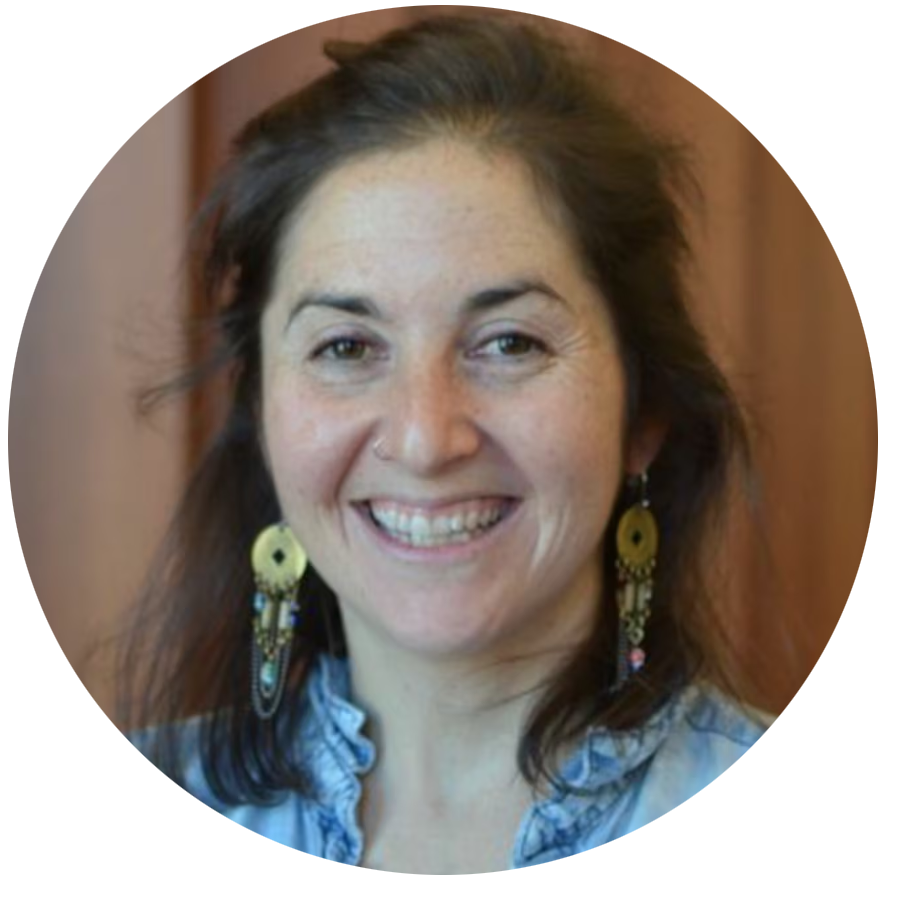 Sabrina Shankman
Sabrina Shankman
Reporter, The Boston Globe
Sabrina Shankman covers the climate crisis for the Boston Globe as part of the Into the Red team. She joined the newspaper in 2021 after reporting for eight years at Inside Climate News, where she covered the arctic. Prior to that, she helped produce shows for PBS/Frontline and reported for ProPublica. She has reported on polar bear attacks from a helicopter, stayed in man-camps on Alaska’s North Slope and tracked the path of a terrorist through India and Denmark. At the Globe, her work helps readers understand climate change-fueled extreme weather events, the emerging science and policy of climate change, and the work being done at the state and regional level to address the crisis. Her work has won national recognition, including from the Society of Professional Journalists, the National Headliner Awards, and the Society of American Business Editors and Writers. She got her start as a crime reporter at the Taunton Daily Gazette, and has a masters in journalism from U.C. Berkeley.
About the Panelists:
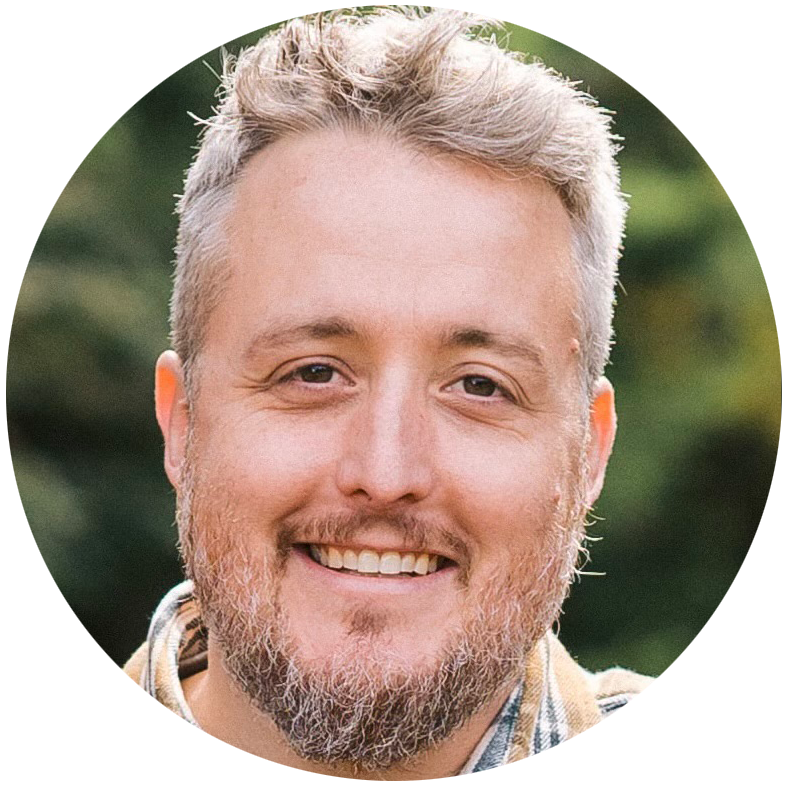 Anthony Bollasina, PG
Anthony Bollasina, PG
Section Chief, Emerging Contaminants Unit, New York State Department of Environmental Conservation (NYSDEC)
Anthony Bollasina, P.G. is a geologist with over a decade of experience in environmental remediation and sustainability, specializing in emerging contaminants such as per- and polyfluoroalkyl substances (PFAS) and 1,4-dioxane. As Section Chief of the Emerging Contaminants Unit at the New York State Department of Environmental Conservation (NYSDEC), Anthony oversees environmental investigations of PFAS and 1,4-dioxane sites, ensuring public health and environmental safety. Prior to this, he worked at Terracon as an Environmental Staff Geologist, managing fieldwork and environmental projects, including Phase II Site Assessments, remedial design, and third party construction oversight.
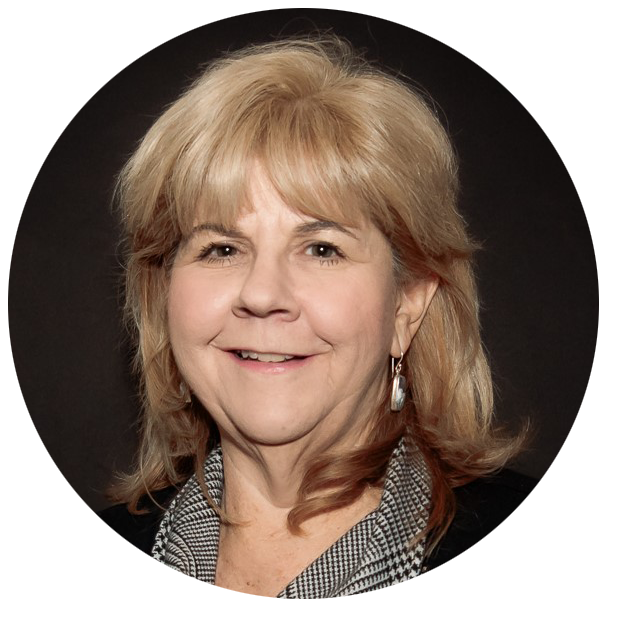 Elizabeth Denly
Elizabeth Denly
Vice President, PFAS Initiative Leader & Chemistry Director, TRC
Ms. Denly serves as TRC’s PFAS Initiative Leader & Chemistry Director. Ms. Denly is currently serving on the Interstate Technology and Regulatory Council (ITRC) PFAS team, is a co-leader on the PFAS History & Use Naming Conventions sub-team, serves as a trainer for this team, and won the 2017 and 2022 ITRC Industry Affiliates Award for her contributions to this team. She was also elected to serve on the ITRC board. She works on many different types of PFAS investigations with a specific focus on risk liability assessment/management plans, chemistry, sampling procedures, data interpretation, forensics, QA/QC, and analytical methodologies. Her major areas of expertise include emerging contaminants, data evaluation, quality assurance project plans, data usability assessments, field and laboratory audits, and consulting for regulatory agencies.
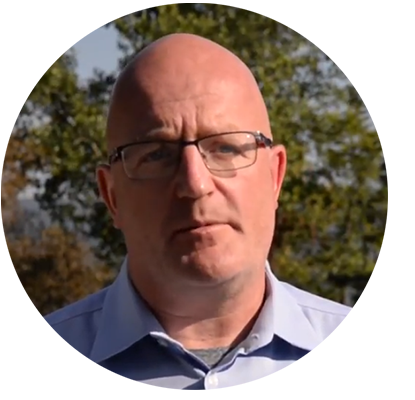 Grant Carey, PhD
Grant Carey, PhD
President, Porewater Solutions
Dr. Grant Carey is President of Porewater Solutions, and he has more than 30 years of experience focusing on the characterization and remediation of hundreds of impacted sites. Dr. Carey currently specializes in PFAS fate and remediation, environmental forensics, groundwater modeling, and research and development. Dr. Carey has developed the In-Situ Remediation Model (ISR Model) which is a three-dimensional reactive transport model for simulating the performance of in-situ sorption barriers for PFAS and chlorinated solvent plumes. Dr. Carey is collaborating with various university partners to advance PFAS research including a number of SERDP-ESTCP projects for the U.S. Department of Defense. Dr. Carey is also an Adjunct Research Professor at Carleton University in Ottawa, Canada and an Adjunct Professor at the University of Toronto. Dr. Carey has published more than 100 short courses, seminars, and papers, and he has developed and delivered professional education based on interactive classroom, e-learning, and web seminars. Dr. Carey has participated on numerous ITRC projects involving the development of industry guidance manuals including for PFAS. Dr. Carey is also participating in the development of a National Ground Water Association White Paper on PFAS Forensics.
 Maureen Dooley
Maureen Dooley
Vice President – Industrial Sector, REGENESIS
Maureen Dooley has over twenty-five years of experience in many aspects of the remediation industry, including project management, research and development, senior technical oversight, remedial design and laboratory management. Her prior experience includes the completion of numerous treatability studies designed to evaluate the biodegradation of a wide range of chemical constituents including chlorinated solvents, petroleum hydrocarbons, explosives, aromatic hydrocarbons, and pesticides. In her current role at REGENESIS, she provides technical leadership for complex soil and groundwater remediation projects, including PFAS groundwater contamination treatment, throughout North America, as well as remediation design, strategy, and business development in the northeastern United States and eastern Canada.
Recording now available
PFAS Regulatory Update and What’s to Come
In this webinar we were pleased to have special guest speaker Taryn McKnight, VP of Product and PFAS Practice Leader for Eurofins Environment Testing (USA). Her presentation discussed regulatory actions at both the federal and state level to address PFAS contamination heading into the US election in November.
Highlights of this free webinar:
- USEPA launched the first PFAS Strategic Roadmap in 2021, focusing on research, restriction, and remediation through 2024
- An updated PFAS roadmap is being prepared to guide future actions
- A new administration may introduce changes to the agenda.
- Review of important rulemaking still in progress, critical implications of those recently enacted, and an update on the state of the science as it relates to these laws
Complete the form on this page to view this free webinar.
Recording now available
Prioritizing Actions to Address Exposure to PFAS
In this webinar we were pleased to have leading PFAS expert Ali Ling, PE, PhD, Assistant Professor of Civil Engineering at the University of St. Thomas. Her presentation discussed prioritizing actions to address exposure to PFAS. She was joined by Paul Erickson, PhD, Vice President of Research and Development at REGENESIS.
Webinar Highlights:
- There are two primary reasons we should increase prioritization of reducing PFAS uses and emissions
- First, human PFAS intake is dominated by food intake and indoor dust inhalation, both directly related to PFAS use domestic and agricultural settings
- Second, the amount of PFAS we are using and emitting currently dwarfs the economically feasible rate of environmental remediation
Complete the form on this page to view this free webinar.
Recording now available
PFAS Source Differentiation at Airports
In this webinar we were pleased to have a special presentation from leading PFAS remediation expert, Dan Schneider, Senior Principal and National Director for Site Investigation and Remediation at Terracon. His presentation discussed PFAS source differentiation at airports. He was joined by Maureen Dooley, Vice President – Industrial Sector at REGENESIS.
Highlights of this free webinar:
- An overview of the landscape of PFAS at Airport sites
- Developing “Lines of Evidence” to support PFAS source identification and differentiation
- PFAS desktop review progress tracker, a resource for information about potential on- and off-airport PFAS sources
- Source identification using desktop reviews, info on historical operations, airport site characteristics, potential off-site sources, and laboratory analytical data
Complete the form on this page to view this free webinar.
Recording now available
The Fallacy of Pumping to Remove PFAS from Aquifers & Proven Advantages of In Situ Remediation
In this webinar we were pleased to have Scott Wilson, President and CEO of REGENESIS share information on the misconceptions surrounding the use of pumping groundwater to flush PFAS from aquifers. In situ PFAS remediation was then explained and an overview was presented of performance expectations of this widely adopted remediation approach.
Highlights of this free webinar:
- Elimination of PFAS Risk
- Time required to pump aquifers of PFAS hazard
- Expansion of risk and liability due to pumping generating PFAS waste
- Impact and ramifications of CERCLA designation relating to liability and risk
- US Defense Department budget language directing use of cost-effective in situ remediation
- Key scientific research cited in support of in situ remedial approach for PFAS
- Design of colloidal activated carbon remediation system
- Longevity of in situ treatment with colloidal carbon
- Costs of PFAS remediation on actual projects
- In situ treatment – elimination of all PFAS risk and liability
Complete the form on this page to view this free webinar.
Recording now available
Colloidal Activated Carbon Performance and Long-term Strategies for In Situ PFAS Remediation
In this webinar we were pleased to have a presentation by Grant Carey, PhD, President of Porewater Solutions. His presentation provided an overview of colloidal activated carbon (CAC) performance and long-term strategies for in-situ PFAS remediation based on several case studies.
Highlights of this free webinar:
- Strategies for site characterization and feasibility studies at PFAS sites where CAC is likely to be considered as a remedy.
- Evaluating the effect of barrier placement (e.g., near source versus downgradient site boundary) on long-term performance.
- Modeling the effects of coastal site tidal fluctuations and groundwater geochemistry on CAC performance.
- Influence on CAC longevity from chromatographic separation of short-chain compounds such as PFBS inside the barrier.
- Strategies for long-term site management after implementation of a CAC remedy.
- Implications of EPA’s final PFAS National Primary Drinking Water Regulation with the implementation of CAC for PFAS remediation.
Complete the form on this page to view this free webinar.
Webinar recording now available
SourceStop: Effective PFAS Treatment for Soil and Groundwater in Source Areas
In this webinar we were pleased to have a special presentation by Paul Erickson, PhD, Vice President of Research & Development at REGENESIS, and Steve Barnes, Director of Remediation Services at REGENESIS. Their presentation provided an overview of a new technology for the effective treatment of PFAS-contaminated soil and groundwater in the source area.
Highlights of this free webinar:
- Available in solid and liquid formulations, SourceStop® allows treatment to be customized to meet the specific needs of any site.
- Significantly reduces the leaching of soil contamination and halts the migration of PFAS in groundwater, eliminating risk to downgradient receptors.
- Safe and easy to handle, SourceStop liquid and solid formats can be used independently, in combination, or with a downgradient PlumeStop barrier to provide a complete, low-cost, zero-waste solution for PFAS sites.
Complete the form on this page to view this free webinar.

 Americas
Americas Europe
Europe Français
Français Deutsch
Deutsch Italiano
Italiano Español
Español